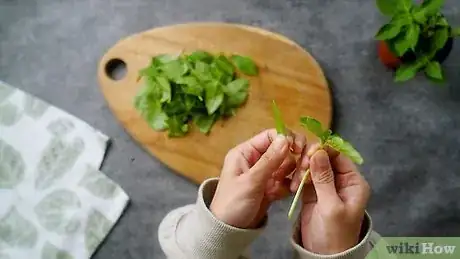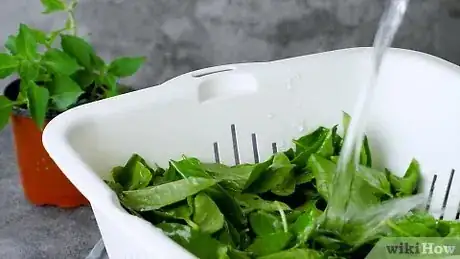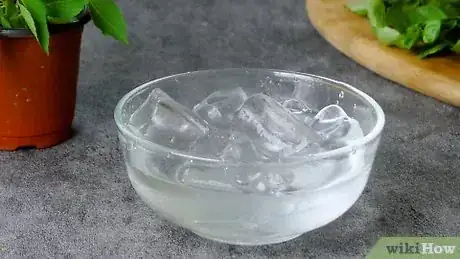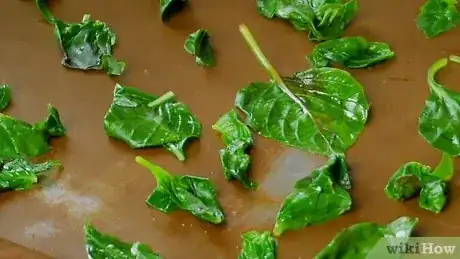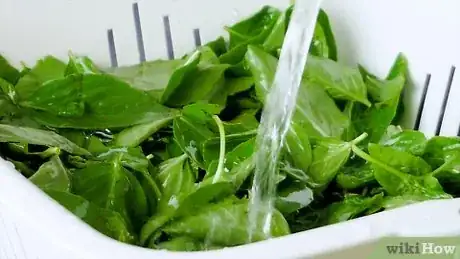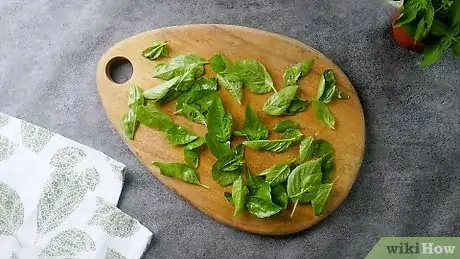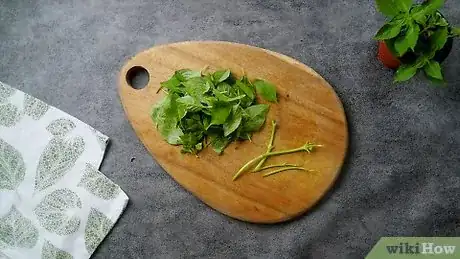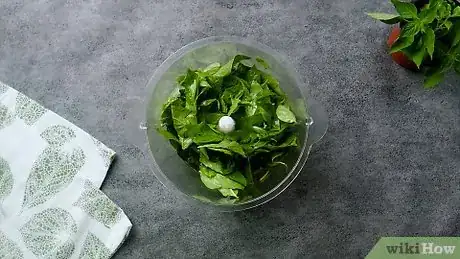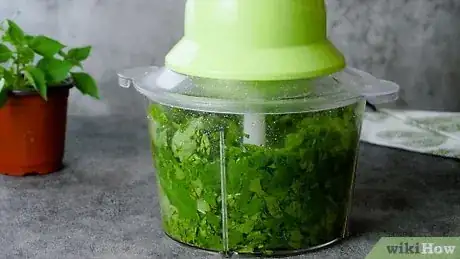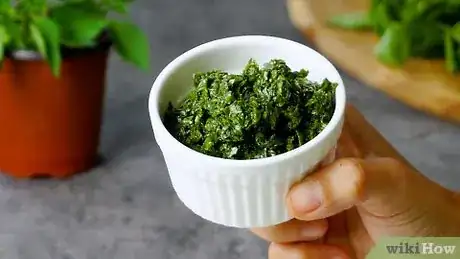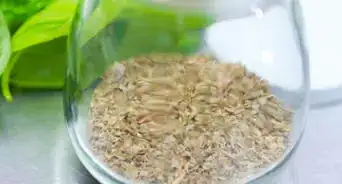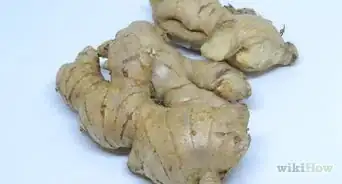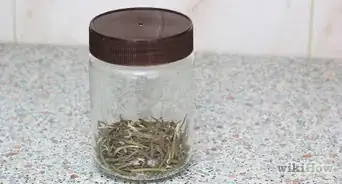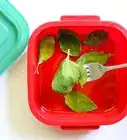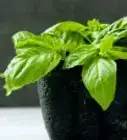This article was co-authored by Ollie George Cigliano. Ollie George Cigliano is a Private Chef, Food Educator, and Owner of Ollie George Cooks, based in Long Beach, California. With over 20 years of experience, she specializes in utilizing fresh, fun ingredients and mixing traditional and innovative cooking techniques. Ollie George holds a BA in Comparative Literature from The University of California, Berkeley, and a Nutrition and Healthy Living Certificate from eCornell University.
wikiHow marks an article as reader-approved once it receives enough positive feedback. This article received 15 testimonials and 100% of readers who voted found it helpful, earning it our reader-approved status.
This article has been viewed 467,149 times.
Basil is a rich source of nutrients and adds amazing flavor and scent to a number of dishes, from Caprese Salad to Chicken Parmesan.[1] Freezing fresh basil allows you to keep it on hand for your favorite recipes all year round. To freeze basil, blanch the leaves, flash freeze them separately, then combine and freeze them long-term in an airtight, freezer-safe container. If you don't need to preserve individual leaves, you can also freeze basil without blanching and flash freezing it, or you can freeze basil in puréed form.
Steps
Freezing Fresh Basil
-
1Remove all of the leaves from the stems. You can clip or pinch the leaves away from the stems.[2]
-
2Thoroughly rinse the leaves in cold water. Use a salad spinner to do the job more effectively. If you don't have one, washing the leaves in a bowl of water and using paper towels to dry them will work too.Advertisement
-
3Place some ice in a bowl of cold water.
-
4Boil a pot of water. It should be big enough to hold the basil leaves.
-
5Add the basil leaves to the water and blanch them for 5-10 seconds. Be very vigilant to make sure you don't blanch them for longer than this. Move the pot to a different burner so it cools off as quickly as possible.
-
6Place the leaves into the ice water using a slotted spoon. Do this as quickly as you can so that the basil stops cooking.
-
7Lay the leaves on a paper towel. This is the part that takes the longest, so be patient. Just use your hands to individually lay out each leaf and then use a paper towel to pat them dry. You can let the leaves dry for 5-10 minutes if you like.
-
8Place the leaves on cookie sheets or plates. Lay them out individually so they don't touch each other too much. You may find that you have to use two pans lined with cookie sheets.
-
9Flash freeze the leaves. Place the cookie sheets with the leaves in the freezer and wait until the leaves are fully frozen. Then, remove them from the freezer.
-
10Place the leaves in a container. You can use a zip-lock bag, Tupperware, an empty milk carton, or another container that you can seal easily.[3]
Quickly Freezing Fresh Basil
-
1Clip the leaves from the stems.
-
2Rinse the leaves thoroughly.
-
3Spread them on a surface and air dry them for at least 30 minutes. You can just use the counter, a cookie sheet, or a plate. You can use a paper towel to pat them dry to speed up the process.
-
4Place them in a storage bag. You can loosely layer the leaves in the bag, making sure that they are fully dry so they don't stick together. A zip-lock bag, Tupperware, or any container with a seal will do.
Freezing Puréed Basil
-
1Pinch or snip off each basil leaf and discard the stems. You won't need the stems when you freeze the basil. If you harvest basil from your garden during the middle of the growing season, snip or pinch off the top 5 or 6” (12.7 to 15.2 cm) so that you leave some stems and leaves to keep on maturing.
-
2Rinse the basil under cold, running water. You can also put the basil in a bowl of cold water and let it soak. Drain the water from the basil. Put the basil in a colander and let it drain thoroughly.
- Gently pat the basil dry with paper towels. Basil is fragile, so pat the leaves gently or let them rest nestled between paper towels until they are dry.
-
3Place 1- 2 handfuls of basil in your food processor. Fill up the food processor bowl, but don’t pack the leaves too tightly.
-
4Use the “pulse” setting to chop the basil. This will result in coarsely chopped leaves; if you want to make a paste, use the manufacturer's suggested setting on your food processor. This should only take a few seconds. The more finely you want to chop the basil, the longer you should process it.
-
5Drizzle olive oil over the basil while you are chopping it. Olive oil prevents the basil from turning dark or even black when it is frozen and gives it a richer flavor. You should use about 2-3 tablespoons of olive oil for each batch of basil. Using olive oil is optional. If you'd like to skip it but still freeze the basil in ice cube trays, you can add enough water to form a slush in the processor instead.[4]
-
6Spoon the chopped basil into freezer containers or ice cube trays.[5] If you use ice trays, you can transfer the basil cubes to larger containers after freezing them for 12 hours.
-
7Use your frozen basil. You can leave them in the freezer for months and take them out and use them for recipes whenever you like, especially in the winter months.[6] They'll separate from each other easily so you won't have to pull them apart. If you're putting them into a heated dish, then just throw in the frozen leaves and wait for them to thaw -- you won't have to thaw them on your own.
- If you have too much frozen basil, give it away to your friends -- they'll love you for it.
Expert Q&A
-
QuestionCan fresh basil leaves be frozen?
 Ollie George CiglianoOllie George Cigliano is a Private Chef, Food Educator, and Owner of Ollie George Cooks, based in Long Beach, California. With over 20 years of experience, she specializes in utilizing fresh, fun ingredients and mixing traditional and innovative cooking techniques. Ollie George holds a BA in Comparative Literature from The University of California, Berkeley, and a Nutrition and Healthy Living Certificate from eCornell University.
Ollie George CiglianoOllie George Cigliano is a Private Chef, Food Educator, and Owner of Ollie George Cooks, based in Long Beach, California. With over 20 years of experience, she specializes in utilizing fresh, fun ingredients and mixing traditional and innovative cooking techniques. Ollie George holds a BA in Comparative Literature from The University of California, Berkeley, and a Nutrition and Healthy Living Certificate from eCornell University.
Private Chef & Food Educator Of course! That said, you should avoid leaves that are drooping or blackened.
Of course! That said, you should avoid leaves that are drooping or blackened.
Warnings
- Be sure to thoroughly coat the basil leaves while you are chopping them in the food processor. The oil will help the basil retain flavor and moisture, as well as keep the leaves from turning dark.⧼thumbs_response⧽
Things You’ll Need
- Paper towels
- Kitchen shears (optional)
- Colander
- Spoon
- Food processor
- Olive oil
- Ice cube trays
- Resealable plastic bag
- Salad spinner (optional)
References
- ↑ http://www.nutrition-and-you.com/basil-herb.html
- ↑ https://www.food.com/recipe/freezing-herbs-basil-rosemary-thyme-oregano-cilantro-parsl-422240
- ↑ Ollie George Cigliano. Private Chef & Food Educator. Expert Interview. 31 January 2022.
- ↑ http://www.kalynskitchen.com/2006/06/how-to-freeze-fresh-basil-weekend-herb.html
- ↑ Ollie George Cigliano. Private Chef & Food Educator. Expert Interview. 31 January 2022.
- ↑ Ollie George Cigliano. Private Chef & Food Educator. Expert Interview. 31 January 2022.
- http://www.kalynskitchen.com/2006/06/how-to-freeze-fresh-basil-weekend-herb.html
About This Article
To freeze basil, start by removing the stems and rinsing the leaves in cold water. Next, place the leaves in a mesh strainer with a handle and dip the basil into a boiling pot of water for no more than 5-10 seconds. Then, immediately place the leaves into a bowl of ice water so that they stop cooking. After that, lay each leaf flat on a paper towel and allow the basil to dry, then put the leaves on a cookie sheet and place it in the freezer. Once the leaves are fully frozen, put them in a zip-lock bag or plastic container. For more tips, like how to freeze puréed basil, read on!
